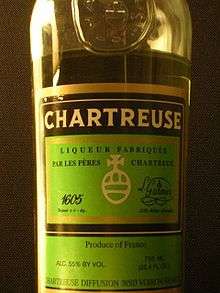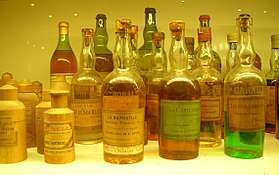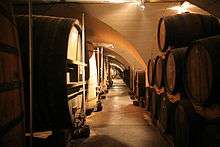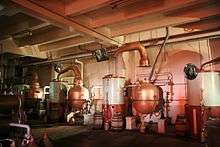Chartreuse (liqueur)
 Bottle of Green Chartreuse  A shot glass full of Chartreuse | |
| Type | Liqueur |
|---|---|
| Manufacturer | Carthusian monks |
| Country of origin | Voiron, France |
| Introduced | 1764 |
| Alcohol by volume | 40–55% |
| Proof (US) | 80–110 |
| Color | Green or yellow |
| Flavour | herbal |
Chartreuse (pronounced [ʃaʁtʁøz]) is a French liqueur made by the Carthusian Monks since 1737 according to the instructions set out in a manuscript given to them by François Annibal d'Estrées in 1605. It is composed of distilled alcohol aged with 130 herbs, plants and flowers. The liqueur is named after the monks' Grande Chartreuse monastery, located in the Chartreuse Mountains in the general region of Grenoble in France. The liqueur is produced in their distillery in the nearby town of Voiron (Isère). Until the 1980s, there was another distillery at Tarragona in Spain.[1][2]
Chartreuse gives its name to the color chartreuse, which was first used as a term of color in 1884.[3] It is one of the handful of liquors that continue to age and improve in the bottle.[4]
Types

Green Chartreuse
Green Chartreuse (110 proof or 55% ABV) is a naturally green liqueur made from 130 herbs and other plants macerated in alcohol and steeped for about 8 hours. A last maceration of plants gives its color to the liqueur.
Yellow Chartreuse
Yellow Chartreuse (80 proof or 40%), which has a milder and sweeter flavour and aroma.
Chartreuse VEP
VEP stands for Vieillissement Exceptionnellement Prolongé,[5] meaning “exceptionally prolonged aging.” It is made using the same processes and the same secret formula as the traditional liqueur, and by extra long aging in oak casks it reaches an exceptional quality. Chartreuse VEP comes in both yellow and green.
Élixir Végétal de la Grande-Chartreuse
Élixir Végétal de la Grande-Chartreuse (138 proof or 69% – also 142 proof or 71%) has the same base of about 130 medicinal and aromatic plants and flowers but is far stronger. It can be described as a cordial or a liqueur, and is claimed to be a tonic. Sold in small wood-covered bottles.
Liqueur du 9° Centenaire
Liqueur du 9° Centenaire (47%) was created in 1984 to commemorate the 900 year anniversary of the foundation of the abbey. It is similar to Green Chartreuse, but slightly sweeter.
Chartreuse 1605 – Liqueur d'Elixir
Chartreuse 1605 – Liqueur d'Elixir (56%) was created to commemorate the return of a mysterious manuscript concerning an elixir of long life to the Carthusian monks by Marshal François Annibal d'Estrées.
White Chartreuse
White Chartreuse (30%) was produced and sold between 1860 and 1900.[6]
Génépi
The monks make a Génépi which is the general term in the Alps for a homemade or local liquor featuring local mountain flora. There are hundreds or even thousands of different Génépi liquors made, many simply by families for their own use each year. As they have been making Chartreuse from local plants for centuries, the monks started in the 2000s to make a Génépi as a sideline product. It is labelled "Génépi des Pères Chartreux" and is generally only available locally in a 70cl bottle, usually labelled 40% alcohol.
Meilleurs Ouvriers de France
In 2007, a special edition was created by the Meilleurs Ouvriers de France Sommeliers (Best Craftsmen of France) in partnership with the distillery. It is yellow in color (40% alcohol).[7]
Flavour
Chartreuse has a very strong characteristic taste. It is very sweet, but becomes both spicy and pungent. It is comparable to other herbal liqueurs such as Galliano, Liquore Strega or Kräuterlikör, though it is distinctively more vegetal. Like other liqueurs, its flavour is sensitive to serving temperature. If straight, it can be served very cold, but is often served at room temperature. It is also featured in some cocktails. Some mixed drink recipes call for only a few drops of Chartreuse due to the assertive flavour. It is popular in French ski resorts where it is mixed with hot chocolate and called Green Chaud.[8]
History



According to tradition, a marshal of artillery to French king Henry IV, François Hannibal d'Estrées, presented the Carthusian monks at Vauvert, near Paris, with an alchemical manuscript that contained a recipe for an "elixir of long life" in 1605.[9] The recipe eventually reached the religious order's headquarters at the Grande Chartreuse monastery, in Voiron, near Grenoble. It has since then been used to produce the "Elixir Végétal de la Grande Chartreuse". The formula is said to include 130 herbs, plants and flowers and secret ingredients combined in a wine alcohol base.[10]
The book The Practical Hotel Steward (1900) states that green chartreuse contains "cinnamon, mace, lemon balm, dried hyssop flower tops, peppermint, thyme, costmary, arnica flowers, genepi, and angelica roots", and that yellow chartreuse is, "Similar to above, adding cardamom seeds and socctrine aloes."[11] However the recipe remains a secret. The monks intended their liqueur to be used as medicine. The recipe was further enhanced in 1737 by Brother Gérome Maubec.
The beverage soon became popular, and in 1764 the monks adapted the elixir recipe to make what is now called Green Chartreuse.[10]
In 1793, the monks were expelled from France along with all other Religious Orders and manufacture of the liqueur ceased. A copy of the manuscript was made and kept at the Monastery. The original left with the monks. On the way there, the monk was arrested and sent to prison in Bordeaux. He was not searched and was able to secretly pass the manuscript to one of his friends: Dom Basile Nantas. This friend was convinced that the order would remain in Spain and never come back and that the manufacturing of the liqueur would cease. He sold the manuscript to a pharmacist in Grenoble, Monsieur Liotard. In 1810, Napoleon ordered that all "secret" recipes of medicine be sent to the Ministry of Interior for review. The manuscript was sent and returned as "Refused" as it was not a secret but well known. At the death of the pharmacist, his heirs returned the manuscript to the monks who had been back at the Monastery since 1816.[10]
In 1838, they developed Yellow Chartreuse, a sweeter version of the Green Chartreuse, 40% alcohol liqueur (80° proof).[10]
The monks were again expelled from the monastery following a French law in 1903, and their real property, including the distillery, was confiscated by the government. The monks took their secret recipe to their refuge in Tarragona, Catalonia, and began producing their liqueurs with the same label, but with an additional label which said Liqueur fabriquée à Tarragone par les Pères Chartreux ("liquor manufactured in Tarragona by the Carthusian Fathers"). At the same time, the "Compagnie Fermière de la Grande Chartreuse", a corporation in Voiron that obtained the Chartreuse assets, produced a liqueur without benefit of the monks' recipe which they sold as Chartreuse. While the French corporation was acting legally in France, the monks successfully prevented the export of the liqueur to many other countries, since the order retained ownership of its foreign trademark registrations, largely because the recipe had been kept secret.[12][13] On the night of the sinking of the Titanic in 1912, one of the proposed dishes for First class was a Chartreuse based dessert.[14] Sales at the French company were very poor, and by 1929, it faced bankruptcy. A group of local businessmen in Voiron bought all the shares at a low price and sent them as a gift to the monks in Tarragona.[10]
After regaining possession of the distillery, the Carthusian brothers returned to the monastery with the tacit approval of the French government and began to produce Chartreuse once again. Despite the eviction law, when a mudslide destroyed the distillery in 1935, the French government assigned Army engineers to relocate and rebuild it at a location near Voiron where the monks had previously set up a distribution point. After World War II, the government lifted the expulsion order, making the Carthusian brothers once again legal French residents.[10]
Today, the liqueurs are produced in Voiron using the herbal mixture prepared by two monks at Grande Chartreuse. They are the only ones to know the secret recipe. The marketing, bottling, packaging, management of the distillery and tours are done by Chartreuse Diffusion, a company created in 1970.[10] Other related alcoholic beverages are manufactured in the same distillery (e.g. Génépi). The exact recipes for all forms of Chartreuse remain trade secrets and are known at any given time only to the two monks who prepare the herbal mixture. Chartreuse is commonly used as an ingredient in cocktails, such as a Cloister.[15]
Accolades
Chartreuse liquors generally have performed well at international spirit ratings competitions. The basic green offering has won silver and double gold medals from the San Francisco World Spirits Competition. It has also earned an above-average score of 93 from the Beverage Testing Institute and has been given scores in the 96-100 interval by Wine Enthusiast.[16] The VEP Green and VEP Yellow have generally earned similarly impressive scores.[17] The basic Yellow Chartreuse has received more modest (though still average or above) ratings.[18]
In popular culture
- In Hunter S. Thompson's Generation of Swine, chartreuse is mentioned on occasion and most notably drunk by Tex and Loretta in the chapter "Doomed Love in the Rockies".
- In the Alfred Hitchcock film The Lady Vanishes, a character on the train specifically orders green Chartreuse.
- In F. Scott Fitzgerald's The Great Gatsby, chartreuse is a popular drink among the major characters, is mentioned often, and is specifically enjoyed by Gatsby, Nick, and Daisy after Gatsby first reveals himself to Daisy and gives her a tour of his house.
- In the 1950 novel by Josephine Tey, To Love and Be Wise, Inspector Alan Grant enjoys a glass of Chartreuse with his companion Marta Hallard before dinner.
- In chapter 23 of John Steinbeck's 1954 novel, Sweet Thursday, Doc and Suzy start off their dinner date with a cocktail, "The Webster F. Street Lay-Away Plan — a martini made with chartreuse instead of vermouth. Very good."
- In the short story "Reginald on Christmas Presents" (contained in the 1904 collection Reginald by Edwardian English author Saki), the title character declares that "people may say what they like about the decay of Christianity; the religious system that produced green Chartreuse can never really die."
- In Evelyn Waugh's novel Brideshead Revisited, Anthony Blanche and the narrator Charles Ryder drink Chartreuse after dinner. Anthony muses that it's "Real G-g-green Chartreuse, made before the expulsion of the monks. There are five distinct tastes as it trickles over the tongue. It is like swallowing a sp-spectrum."
- In Poppy Z. Brite's novel Lost Souls, Chartreuse features heavily, serving as the main drink of the New Orleans' Vampire protagonists. In the prologue the author states that 'Chartreuse glows in the dark, and if you drink enough of it, your eyes will turn bright green.', notable for the eyes of the main vampire, Zillah, whose eyes are said to be the color of Chartreuse.
- In Ted Conover's book Whiteout, Conover is asked to deliver five bottles of green Chartreuse to Hunter Thompson, but is turned down by Airport Liquors in Aspen because Thompson had already bought all the Chartreuse they had in stock.
- In Nicholas Pileggi's book Wiseguy: Life in a Mafia Family, Henry Hill drinks Screaming Eagles ("shot glasses of white Chartreuse dropped into large goblets of chilled champagne") prior to turning himself into jail.[19]
- In Quentin Tarantino's Death Proof, the bar owner Warren (Quentin Tarantino) serves a green liqueur. After being asked what was just served, Warren says, "Chartreuse, the only liqueur so good they named a color after it."
- The Tom Waits song "Til the Money Runs Out" from his 1980 album Heartattack and Vine contains the couplet "with a pint of green chartreuse ain't nothin seems right/you buy the Sunday paper on a Saturday night." His song "$29.00," from the album Blue Valentine, refers to a "Fleetwood with the chartreuse hood."
- The 2000 Morphine song "Top Floor Bottom Buzzer" on the album The Night contains the lines, "... It was later it was after two. We found a bottle of the good Chartreuse. The lights were green and gold. We played Latin soul. ..."
- The 2012 ZZ Top song "Chartreuse" on the album La Futura, which is about how well one feels when consuming Chartreuse.
- In the movie "We're No Angels" (1955) Madame Parole purchases a bottle of Chartreuse in the Ducotel's store.
- In the 1960s cult gothic-horror series Dark Shadows, during the 1897 episodes, Chartreuse is ordered for the diabolical Count Andreas Petofi by his loyal henchman, Aristede, at the Blue Whale tavern.
- Phryne Fisher, from Kerry Greenwood's Phryne Fisher mystery novels, favors Green Chartreuse liquor after meals.
- In the Spenser novel Sudden Mischief by Robert B. Parker Brad Sterling has a glass of Chartreuse during a meeting with Spenser at an outdoor cafe on Newbury St. in Boston.
See also
- Chartreuse, a web color named originally in 1987 after Green Chartreuse liqueur
- Chartreuse yellow, a color originally named "chartreuse" in 1892 after Yellow Chartreuse liqueur, but since 1987 called "chartreuse yellow" to avoid confusion with the green version of chartreuse
- Stellina, a similar monastic liqueur made in the same region as Chartreuse
- Frangelico, an example of a liquor created in recent times "based on" a legend or story about a monastic recipe
- Bénédictine, an example of a liquor created in recent times "based on" a monastic recipe
- Centerbe, an Italian liqueur of pale green color made of mountain herbs.
References
- ↑ "Green Chartreuse, Tarragona Bot. 1980s". The Whisky Exchange.
- ↑ "The Chartreuse Distilleries". Chartreuse.
- ↑ The Oxford English Dictionary (Second ed.). 1989.
- ↑ Hecht, Alex (October 2014). "Chartreuse: The only liqueur so good they named a color after it". War on the Rocks. Retrieved 2014-12-02.
- ↑ Chartreuse VEP
- ↑ Sir Thomas Edward Thorpe (1922). A Dictionary of Applied Science. Longmans, Green, and Co. p. 742. Retrieved 31 October 2013.
- ↑ Chartreuse.fr - Liqueur created by the Best Craftsmen of France "Sommeliers"
- ↑ "Green chaud". Retrieved 31 October 2013.
- ↑ "The monks got hold of the recipe, originally a health potion, in 1605 but it was so complex they didn't master it for another century." "Chartreuse Liqueurs". Immaculate Heart of Mary's Hermitage. Retrieved 31 October 2013.
- 1 2 3 4 5 6 7 Chartreuse.fr History of the Chartreuse Liqueurs
- ↑ John Tellman (1900) The Practical Hotel Steward, The Hotel Monthly, Chicago
- ↑ "Monks Sue to Prevent Use of Chartreuse Trademark". San Francisco Call. 7 October 1906. p. 34. Retrieved 1 December 2016.
- ↑ Ladas, Stephen Pericles (1975). Patents, Trademarks, and Related Rights: National and International Protection. Harvard University Press. pp. 1183–. ISBN 9780674657755. Retrieved 1 December 2016.
- ↑ https://www.histoire-pour-tous.fr/histoire-de-france/5404-la-chartreuse-histoire-dune-liqueur-vertueuse.html
- ↑ "The 1605 Manuscript and the Secret of the "Elixir of Long Life"". Archived from the original on 2001-12-23. Retrieved 31 October 2013.
- ↑ "Proof66.com Summary of Chartreuse Green's Awards". Retrieved 31 October 2013.
- ↑ "Proof66.com Summary of Chartreuse VEP Green's Awards". Retrieved 31 October 2013.
- ↑ "Proof66.com Summary of Chartreuse Yellow's Awards". Retrieved 31 October 2013.
- ↑ Nicholas Pileggi, Wiseguy (New York: Pocket Books, 1985), 164.
Works cited
- Harold J. Grossman and Harriet Lembeck, Grossman's Guide to Wines, Beers and Spirits (6th edition). Charles Scribner's Sons, New York, 1977, pp. 378–9. ISBN 0-684-15033-6
External links
| Wikimedia Commons has media related to Chartreuse (liqueur). |